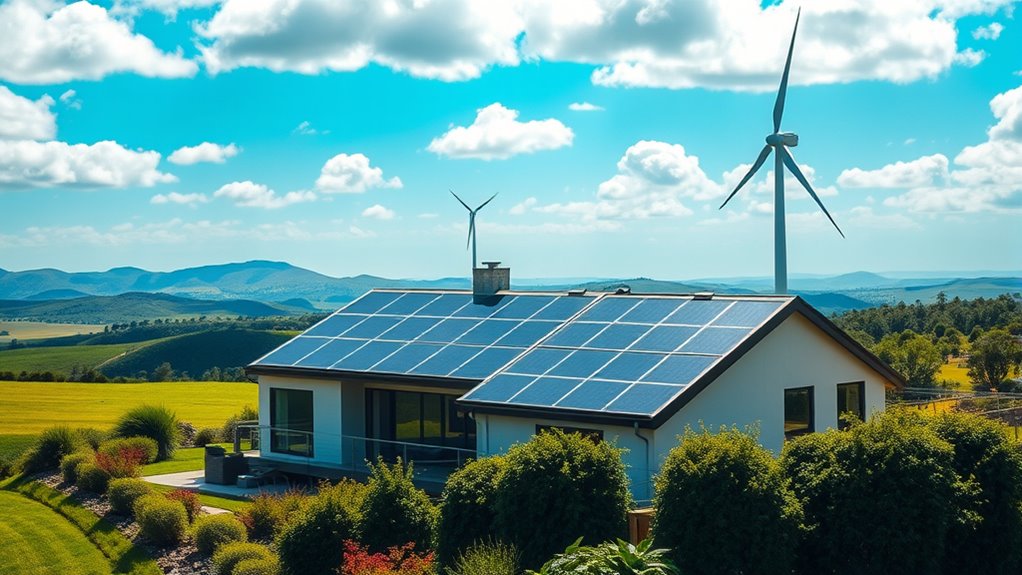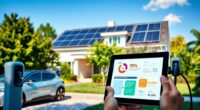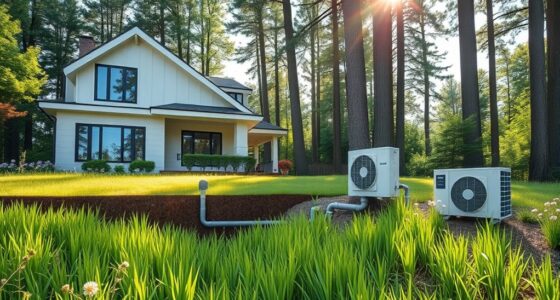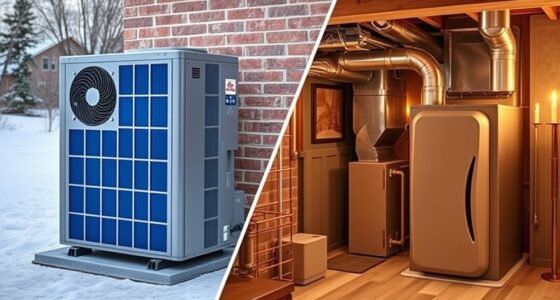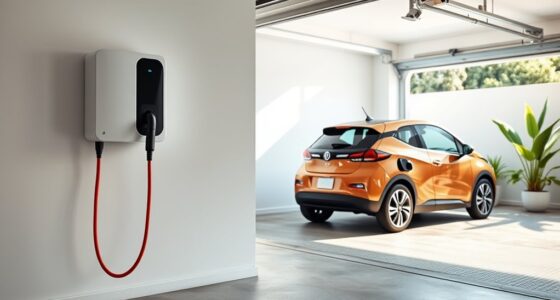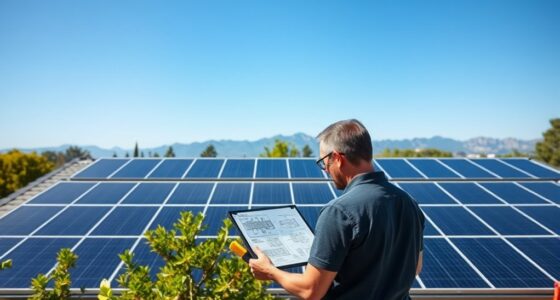Choosing between solar and wind energy depends on where you live and your energy needs. Solar panels work well in most locations, especially with good sunlight, and are easier and cheaper to install, offering consistent power even on cloudy days. Wind turbines are ideal if you have steady, strong winds, but they cost more and need more upkeep. To find the best fit for your home, consider your local climate and space—there’s more to discover that can help you decide.
Key Takeaways
- Solar power is more affordable, easier to install, and suitable for urban or shaded areas, making it ideal for most homes.
- Wind energy offers higher efficiency in locations with consistent, strong winds, but requires more space and maintenance.
- Solar panels provide more consistent energy output day-to-day, while wind turbines depend heavily on local wind conditions.
- Consider your location: solar works well everywhere, but wind is best in rural or coastal areas with steady breezes.
- Evaluate your budget, space, and energy needs to choose the most cost-effective and reliable renewable source for your home.
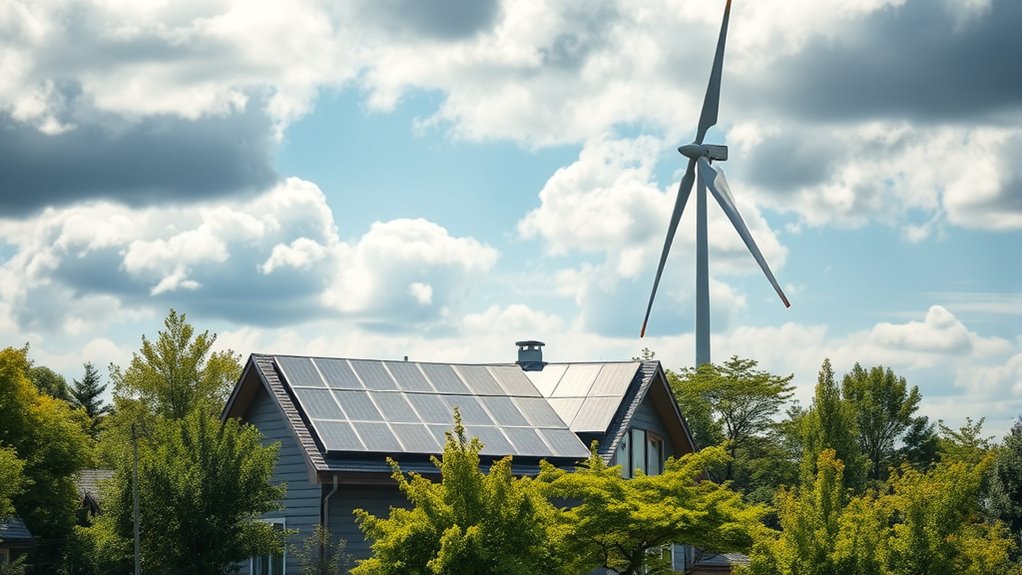
Are you trying to decide between solar and wind energy for your home? Both options have their strengths and challenges, so understanding how they compare can help you make an informed choice. Wind turbines can convert up to 60% of wind energy into electricity, which is considerably more efficient than solar panels, typically converting only about 20-22% of sunlight into usable power. However, solar power tends to produce more consistent energy in residential settings because sunlight is available almost every day, even on cloudy days. Wind turbines have the potential for higher output, but they need strong, steady winds to operate efficiently, which isn’t always guaranteed. Meanwhile, solar energy depends on sunlight, including indirect light, making it a reliable option for most locations, regardless of weather patterns. For instance, in a 14-month experiment in Spokane, Washington, residential solar panels produced about five times more electricity than a wind turbine, illustrating just how dependable solar can be in certain environments. Additionally, performance efficiency varies significantly based on local conditions, influencing overall energy output and reliability.
Solar energy offers more consistent power, while wind can provide higher output in suitable locations.
When it comes to installation and space requirements, solar panels are generally more practical for homes. They can be mounted on rooftops or ground supports, needing roughly 21.2 square meters per kilowatt—space most homes can accommodate. Solar panels are also easier and faster to install, with lower upfront costs averaging around $21,600 for a 7.2-kilowatt system before incentives. Wind turbines, on the other hand, require more open space and clearance, often mounted on tall masts. Installing a wind turbine is more complex, often needing permissions and a suitable site that’s free from obstructions. They also tend to have higher maintenance costs and initial prices, making solar a more budget-friendly option for many homeowners.
Your geographic location plays a big role in which energy source is better suited for your home. Wind energy performs best in rural, coastal, or open areas with consistent wind patterns, while solar panels are versatile enough for urban and suburban rooftops with adequate sun exposure. Solar panels can work in most regions, including cloudy or shaded environments, although efficiency decreases with shading or poor roof orientation. Wind turbines can generate power 24 hours a day if wind conditions are right, but their effectiveness drops considerably without steady wind.
In terms of cost and maintenance, solar power has become more affordable, with decreasing prices and minimal upkeep—mainly occasional cleaning and inspections. Wind turbines are more expensive initially and require more frequent repairs due to mechanical complexity and exposure to harsh conditions. Plus, many regions offer financial incentives and rebates for solar installations, further improving their affordability. When considering reliability, solar panels provide consistent power during daylight hours and are less affected by local obstructions, while wind turbines can generate electricity continuously if the wind blows steadily. Ultimately, your decision should factor in your location, available space, budget, and energy needs to determine which option fits best for your home.
Frequently Asked Questions
How Does Local Climate Affect Solar and Wind Energy Efficiency?
Your local climate directly influences how well solar and wind energy systems perform. If you’re in a sunny, dry area with clear skies, solar panels will generate more power. If you’re in a windy region with steady breezes, wind turbines will be more effective. Factors like temperature, cloud cover, and seasonal weather also matter, so choosing the right system depends on your area’s specific climate conditions.
What Are the Maintenance Costs for Solar Versus Wind Systems?
Ever wonder how much you’ll spend to keep your energy source running smoothly? Maintenance costs for solar systems are quite low, typically $75 to $150 annually, and require only yearly checks. Wind turbines, however, are more expensive, costing between $3,000 and $5,000 each year due to their complex parts and service needs. So, are you prepared for the ongoing investment in maintenance, or would a simpler system suit you better?
Can Both Solar and Wind Systems Be Combined Effectively?
You can definitely combine solar and wind systems effectively, creating hybrid setups that maximize energy production and land use. By integrating solar panels and wind turbines through microgrids or hybrid inverters, you get a more reliable and stable energy supply. This combination reduces intermittency, increases overall output, and provides a more consistent power source, especially with proper planning and suitable location choices. It’s a smart way to enhance renewable energy efficiency for your home.
How Do Government Incentives Differ for Solar and Wind Energy?
You should know that government incentives for solar and wind energy differ mainly in structure and eligibility. Solar offers a 30% federal tax credit with additional state and local benefits, making it attractive for homeowners. Wind incentives include the Production Tax Credit, paid per kilowatt-hour, and the Investment Tax Credit. Both require meeting wage and apprenticeship standards, but solar incentives are more focused on residential applications, while wind favors large-scale projects.
What Is the Typical Lifespan of Solar Panels Compared to Wind Turbines?
Think of solar panels as sturdy trees standing tall for 25 to 30 years, slowly shedding their efficiency, yet still providing energy. Wind turbines, like wind-sculpted sculptures, typically last 20 to 25 years, with proper care. While solar panels often outlive wind turbines, both need regular maintenance to keep their energy flowing. Your choice depends on how long you want your energy source to stand strong and perform reliably.
Conclusion
Choosing between solar and wind energy is like picking the perfect sail or sturdy anchor for your boat. Both can carry you smoothly through the currents of renewable power, but the right choice depends on your home’s location and your energy needs. Imagine your home as a vessel—solar is your bright, guiding star on sunny days, while wind is your steady breeze on cloudy ones. Whichever you choose, you’re steering toward a cleaner, greener future.

